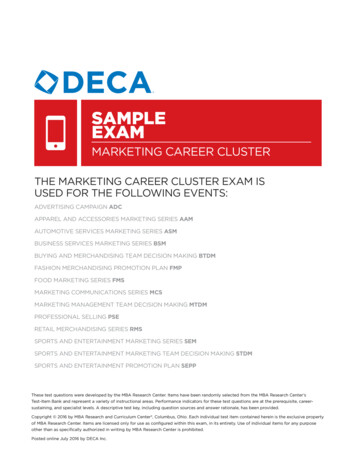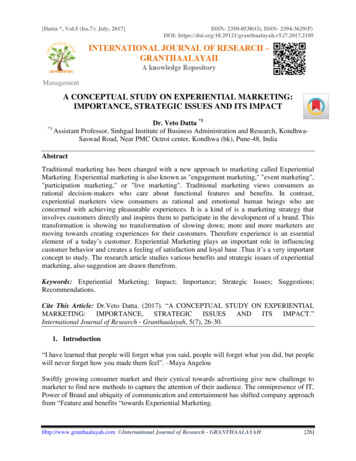
Transcription
Marketing ManagementAbout the TutorialMarketing Management is an organizational discipline, which deals with the practicalapplication of marketing orientation, techniques and methods in enterprises andorganizations and with the management of a company's marketing resources andactivities.This is a brief introductory tutorial that explains the methodologies applied in the rapidlygrowing area of marketing management.AudienceThis tutorial will be useful for students from management streams who aspire to learn thebasics of Marketing Management. Professionals, especially managers, aspirants ofentrepreneurship, regardless of which sector or industry they belong to, can use thistutorial to learn how to apply the methods of Marketing Management in their respectiveenterprise.PrerequisitesTo understand this tutorial, it is advisable to have a foundation level knowledge of businessand management studies. However, general students who wish to get a brief overviewMarketing Management may find it quite useful.Disclaimer & Copyright Copyright 2019 by Tutorials Point (I) Pvt. Ltd.All the content and graphics published in this e-book are the property of Tutorials Point (I)Pvt. Ltd. The user of this e-book is prohibited to reuse, retain, copy, distribute or republishany contents or a part of contents of this e-book in any manner without written consentof the publisher.We strive to update the contents of our website and tutorials as timely and as precisely aspossible, however, the contents may contain inaccuracies or errors. Tutorials Point (I) Pvt.Ltd. provides no guarantee regarding the accuracy, timeliness or completeness of ourwebsite or its contents including this tutorial. If you discover any errors on our website orin this tutorial, please notify us at contact@tutorialspoint.com.i
Marketing ManagementTable of ContentsAbout the Tutorial . iAudience . iPrerequisites . iDisclaimer & Copyright . iTable of Contents . ii1.MARKETING — OVERVIEW. 1What is a Market? . 1Characteristics of a Market . 2Elements of a Market . 2Factors Affecting a Market . 3Objectives of Marketing Management . 52.MARKETING — CONCEPTS . 7Production Concept . 7Sales Concept . 7Marketing Concept . 83.MARKETING — MARKETING PROCESS . 94.MARKETING — FUNCTIONS . 10Major Functions of Marketing Management . 10Selling . 11Buying and Assembling . 12Transportation . 12Storage . 13Standardization and Grading . 13Financing . 14ii
Marketing ManagementRisk Taking . 14Market Information . 145.MARKETING — ENVIRONMENT . 15Types of Layers . 15Organizational Environment . 15Marketing Environment . 15Macro Environment . 15Micro Environment. 166.MARKETING — PORTER’S FIVE FORCES. 17Potential Entrants. 18Bargaining Power of . 18Suppliers. 18Bargaining Power of . 18Buyers . 18Industry Competitors. 18Threat of Substitutes . 187.MARKETING — PLANNING . 198.MARKETING — RESEARCH . 21Global Market Research . 21Marketing Research Vs. Market Research . 229.MARKETING — RESEARCH PROCESS . 23Problem Definition . 23Research Design . 23Data Types and Sources . 24Questionnaire Design . 25iii
Marketing ManagementMeasurement Scales . 25Data Collection . 2510.MARKETING — CONSUMER BEHAVIOR . 27Factors Influencing Consumer Buying Behavior . 27Buying Motive . 2811.MARKETING — OBB . 29Characteristic Features of OBB . 29Determinants of OBB . 29Participants of OBB. 30Steps of OBB . 30Stages in Organizational Buying Process . 31Types of Organizational Market . 3112.MARKETING — SEGMENTATION . 33Objectives of Marketing Segmentation . 33Importance of Segmentation . 34Levels of Market Segmentation . 34Steps in Market Segmentation . 3513.MARKETING — DEMAND FORECASTING . 37Steps in Demand Forecasting. 37Quantitative Techniques . 37Qualitative Techniques . 4014.MARKETING — PRODUCT LIFE CYCLE. 41Stages of Product Cycle . 41Importance of Product Life Cycle . 43New Product Development Process . 43iv
Marketing ManagementStages of New Product Development . 4415.MARKETING — BRANDING OF A PRODUCT . 45Reasons for Branding. 45Branding Strategies . 45Positioning a Brand . 4616.MARKETING — BRAND EQUITY . 47Elements of Brand Equity . 47Brand Benefits . 47Packaging . 48Characteristics of Packaging . 48AIDAS Formula . 49Packaging Strategies . 49Labeling . 49Product Mix . 50Planned Obsolescence . 5017.MARKETING — PRICING DECISION . 51Objectives of Pricing . 51Factors Influencing Pricing . 52Pricing Methods . 53Pricing Strategies . 5418.MARKETING — PROMOTION DECISIONS. 56Integrated Marketing Communication . 56Marketing Communication Process . 56Promotion Decisions. 57Promotion Mix . 57v
Marketing ManagementDirect Marketing . 57Forms of Direct Marketing . 5819.MARKETING — DISTRIBUTION CHANNELS . 59Functions of Distribution Channels . 59Objectives of Distribution Channels . 60Major Channels of Distribution. 60Designing Distribution Channels . 60Classification of Wholesalers . 6120.MARKETING — PHYSICAL DISTRIBUTION . 62Importance of Physical Distribution. 62Steps in Designing a Physical Distribution System . 62Components of a Physical Distribution System . 63Supply Chain Management (SCM) . 6321.MARKETING — ADVANCED TOPICS . 65E-Marketing . 65E-Marketing Vs. Traditional Marketing . 65Green Marketing . 65Services Marketing . 66Customer Relationship Management . 66Rural Marketing. 67vi
1. Marketing — OverviewMarketing ManagementWhat is a Market?A market can be defined as the summation of all the buyers and sellers in an area orregion under consideration. The area may be a country, a region, a state, a village or acity.Market is a place where goods, commodities or services provided by the sellers areswapped with the buyers or purchasers for some value combined with need, demand,supply etc.We can say that it is a place, which satisfies the potential needs of the buyers as well asthe sellers. The market may have a physical existence or a virtual one. It may be local orglobal one.1
Marketing ManagementCharacteristics of a MarketA market has its own characteristic features. It involves only exchange and trade ofcommodities but that activity also has its own features.Let us take a look at the characteristics of a market. A place for swapping goods and services for some value. The goods can beswapped for money, land or some other commodity. This is a place where you can negotiate commodities Coverage of all customer requirements is possible here This is a place for innovation and creation There is potential or capacity for buying and selling. There is share of consumption as well as total part of demand.Let us now take a look at the key elements of the market.Elements of a MarketThe key elements that make a market, without which a market is not complete, or theelements on which a market depends are as follows: Place The area where the swapping of goods, commodities or services takesplace between the seller and the buyer. The place should be convenient to boththe parties. Demand Market runs on supply and demand. A seller provides the products or services and a buyerwants to fulfill his/her requirements. A product with high demand is supplied more. Seller A seller is the person or the party who offers a variety of or even a singleproduct or service to others in return of some valuable item. Buyer A buyer is the person or party who needs a product or service and inreturn is ready to pay some valuable item as demanded by the seller for theproduct. Price This is the cost or the amount that is to be paid for a product or service.It should be fixed; else, it may lead to conflict as well as an imbalance in the sellerbuyer relationship. Government Regulation The government makes some regulations that both the buyer and sellerhave to abide. Everyone is treated equally in front of the law. For example, the buyer is notallowed to sell illegal products while the seller is prohibited from buying them.2
Marketing Management Product Specification It is very important to specify the quantity required, ingredients used and allother details of the product as everybody has different tastes and requirements. It is also notnecessary that what suits one person should suit another.These are the key elements that can make or deteriorate a market. A market runs with allthese elements together; if one of them is removed, there is no market. For example, ifwe remove the buyer from the market, the question of who will purchase the commoditiesarises. In the same way, each element has its own role in the market.Factors Affecting a MarketThere are numerous reasons why a market grows or reduces its profitability. There aredifferent factors affect the growth of a market in many ways.Let us understand the importance and effect of each factor given below on a market withthe help of relevant examples.Number of Buyers and SellersFlipkart offers a special sale offer, where the candidate needs to register for an item inorder to purchase it. In this way, the site gets an idea about the product’s demand andthus it tries to maintain the quantity of the item as per the demand. If the number ofbuyers is more, the product needs to be bought again. However, if the buyers are fewer,then the product needs to be hiked to increase the sale.3
Marketing ManagementTypes of GoodsIf a person wants to buy a car, following things need to be considered: what type of a cardoes he /she need, which brand, what are the brands available, what is the budget, etc.Most importantly, with this factor, one gets a variety of choices in a limited budget.Presence of CompetitionLakme launches a new product, which gives thecustomer three-in-one service. It works as a facewash, face scrub as well as face pack. But thequestion is what was the need.The simple answer is competition; this product is atechnique to attract more customers and cope withthe growing competition.Expectation of buyersWe buy a product only if it stands up to our expectations. Yardley claims that it moisturizesand nourishes the skin for six hours, so a person with dry skin will buy it expecting thatclaim to be true.Cultural FactorsCultural factors like the culture and tradition we follow also affect the market. For example,an Oriya woman would prefer a Sambalpuri saree for some special event over silk or anyother type.4
Marketing ManagementEconomic FactorsAn individual will prefer buying gold only when the rates are down. When the rate isRs 20,000 for 10g, the customers increase while, when the rate is Rs 26,300 for 10g, thecustomers decrease.Social FactorsWhat the market provides is very much dependent on social factors. Analysis shows thatsocial factors impact the business of beverage companies. For example, Pepsi projectsitself as a non-alcoholic beverage because it has to maintain the strict differences incultures around the world.Political FactorsPolitical factors are also important. Something that is banned by the government cannotbe sold in the market, for example, the recent meat ban.Objectives of Marketing ManagementMarketing management is the process of planning & implementing the conception, pricing,promotion and distribution of products or services. It is a target-oriented process and anoperational area of management.5
Marketing ManagementMarketing management is basically an organizational discipline, which focuses on thepractical usage of marketing orientation, techniques and methodologies in companies andorganizations and on the management of a firm's marketing resources and activities.The following are the main objectives of marketing management: To satisfy the clients’ requirements and their objectives. To leverage the gain for the growth of business. To develop customer base for the business. To create an appropriate marketing mix. To raise the quality of life of people. To build a good image of the organization. To maintain the long-run concept.Now, we are clear about the need and objective of marketing management. Movingforward, let us discuss the broad marketing concepts in detail.6
2. Marketing — ConceptsMarketing ManagementMarketing concept is the philosophy that companies should examine the requirements oftheir customers and then make decisions to satisfy those needs in a better manner thanthe competitors.Today, most of the companies have adopted various marketing concepts, but this has notalways been the case. Let us now understand major marketing concepts.The major marketing concepts are: Production concept Sales concept Marketing conceptProduction ConceptAccording to the production concept, a company should focus on those items that it canproduce most efficiently and also focus on creating supply of low-cost items that createthe demand for the products.The key questions that a company needs to ask itself before producing an item are: Can we produce the item? Can enough of it be produced?This concept worked fairly during the 1920s as the items that were produced were largelythose of basic necessity and there was a relatively high level of unfulfilled demand.Virtually everything that could be produced was sold easily by a sales team whose taskwas to complete the transactions at a price fixed by the cost of production. All in all, thisconcept prevailed until the late 1920's.Sales ConceptAccording to this concept, the companies would not only produce the items but would alsotry to convince customers to buy them through advertising and personal selling. Beforeproducing a product, the key questions were: Can we sell the item? Can we account enough for it?This concept paid little attention to whether the item actually was required. The goal simplywas to beat the competition with little focus on customer satisfaction. Marketing was anoperation performed after the product was developed and produced and many peoplecame to relate marketing with hard selling. Even today, people use the word "marketing"when they actually mean “sales.”7
Marketing ManagementMarketing ConceptThe marketing concept relies upon marketing studies to define market segments, theirsize, and their requirements. To satisfy those requirements, the marketing team makesdecisions about the controllable parameters of the marketing mix.This concept was introduced after World War II as the customers could afford to beselective and buy only those items that precisely met their changing needs and theseneeds were not immediately obvious. The key questions changed to: What do customers actually want? Can we improve it while they still want it? How can we keep the customers satisfied?In reply to these discerning customers, companies began to adopt marketing concepts,which includes: Focusing on customer requirements before developing a product Aligning all operations of the company to focus on those needs Realizing a gain by successfully satisfying customer needs over the long-termWhen companies began to adopt this concept, they actually set up separate marketingdepartments whose objective was to satisfy customer needs. Mostly, these departmentswere sales departments with expanded responsibilities. While this widened salesdepartment structure can be found in some enterprises today, many of them havestructured themselves into marketing organizations having a worldwide customer focus.8
3. Marketing — Marketing ProcessMarketing ManagementMarketing process includes ways in which value can be created for the customers to satisfytheir requirements. It is an endless series of actions and reactions between the customersand the companies making attempt to create value for and satisfy the needs of customers.In marketing process, the situation is examined to identify opportunities, the strategy isformulated for a value proposition, tactical decisions are taken, plan is executed, andresults are monitored.The following four steps are involved in the marketing process:Situation AnalysisAnalysis of the situation in which the company finds itself serves as the basis for identifyingchances to satisfy unfulfilled customer needs.Situational and environmental analysis is done to identify the marketing options, tounderstand the company’s own capabilities and to understand the surroundings in whichthe company is operating.Marketing StrategyAfter identifying the marketing options available, a strategic plan is developed to pursuethe identified options. An analysis is done and the best available option is chosen; a planor strategy is made for that option.Marketing Mix DecisionsAt this step, elaborated tactical decisions are made for the controllable parameters of themarketing mix. It includes decisions related to product development, product pricing,product distribution and product promotion.Implementation and ControlFinally, th
Marketing concept is the philosophy that companies should examine the requirements of their customers and then make decisions to satisfy those needs in a better manner than the competitors. Today, most of the companies have a











